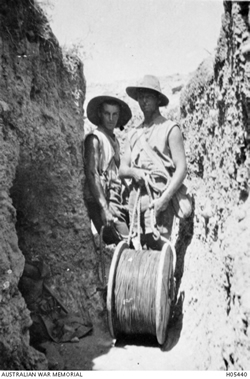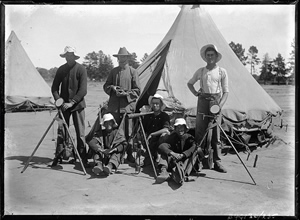Science and technology Stage 3
Overview

Two members of 1st Divisional Signals, AIF, laying cable along a trench at Anzac Cove, 1915
©Public domain (AWM H05440)
Students construct simple electrical circuits incorporating a switch and globe. Students use the switch to send a Morse code message that uses flashes of light. Students label a diagram of their electrical circuit explaining its operation. They state how scientific understanding about electricity was applied to its use during the First World War.
Teaching and learning activities

A group of South Australian Signallers with two 5-inch Mance Mark V heliographs, a telegraph key, a telescope and flags
How is electricity transferred and transformed?
How was scientific understanding about electricity applied to its use during the First World War?
Question and predict
-
Provide context by explaining the important role of signallers in providing military communications. Source: Signaller Silas of the 16th Battalion
-
View images of First World War signallers and telegraph systems. Sources: Signallers on the Somme 1916
-
Explain that the First World War was the first major war to use electrical technologies, including electric signalling lamps, searchlights, radio, electric lights in hospitals. Source: Technology, communications and weapons
-
View images of electricity use in the First World War, for example, the artwork Searchlight by Fred Leist (1917–1918)
-
Explain that advances in technology as a result of the First World War brought new devices into everyday life, for example, radio, television, home appliances.
-
Ask students to predict how electricity is transferred and transformed.
Investigate
-
In groups students construct simple electrical circuits incorporating a switch and globe. Students use the switch to send a Morse code message that uses flashes of light.
-
Students add a buzzer to create a simple electric telegraph system.
-
Connect two Morse code buzzer units with long wires to form a basic telegraph system replicating First World War telegraph communications.
-
Students observe and describe their observations.
Process and analyse data and information
-
Students label a diagram of their electrical circuit explaining its operation.
Communicate
-
Students explain how scientific understanding about electricity was applied to its use during the First World War. This could be in the form of a written or enacted diary entry from a First World War signaller.
Resources:
‘Technology Tom’ explains simple circuits. It is recommended that these are constructed and tested prior to use with students.
Learning concepts
These additional questions can be used for discussion or further investigations.
Challenge
How was electricity used in signalling instruments? What challenges were faced by signallers in running and maintaining cables in the First World War?
Change
How was the newly developed technology of electricity used in First World War? What technological changes in society resulted?
The Science of World War I: Communications
Caring
First World War medical staff cared for patients in temporary hospitals. In what ways did the introduction of electricity improve care? North Beach and the Sari Bair Range – Development page 2
Community
What technologies developed in the First World War continue to be used in the medical community?
Syllabus links
ST3-4WS investigates by posing questions, including testable questions, making predictions and gathering data to draw evidence-based conclusions and develop explanations
ST3-6PW describes how scientific understanding about the sources, transfer and transformation of electricity is related to making decisions about its use
Working scientifically
Students question and predict by:
-
predicting what the findings of an investigation might be (ACSIS231, ACSIS232)
Students plan investigations by:
-
collaboratively and individually selecting suitable methods for gathering data and information first-hand and from reliable secondary sources
Students conduct investigations by:
-
using equipment and materials safely, identifying potential risks (ACSIS088, ACSIS105)
-
accurately observing, measuring and recording data, using digital technologies as appropriate (ACSIS087, ACSIS104)
Students process and analyse data and information by:
-
constructing and using a range of representations, including tables, graphs (column, picture, line and divided bar graphs) and labelled diagrams
-
drawing conclusions and providing explanations based on data and information gathered first-hand or from secondary sources
Students communicate by:
-
using a variety of ways to honestly and accurately communicate ideas, explanations and processes, including multi-modal texts, labelled diagrams, as well as written and oral factual texts as appropriate (ACSIS093, ACSIS110)
Physical world
Electrical circuits provide a means of transferring and transforming electricity. (ACSSU097)
Students:
-
identify potential risks and demonstrate safe use when using electrical circuits and devices
-
demonstrate the need for a circuit to be complete to allow the transfer (flow) of electricity
-
construct simple circuits incorporating devices
-
observe and describe how some devices transform (change) electricity to heat energy, light, sound or movement